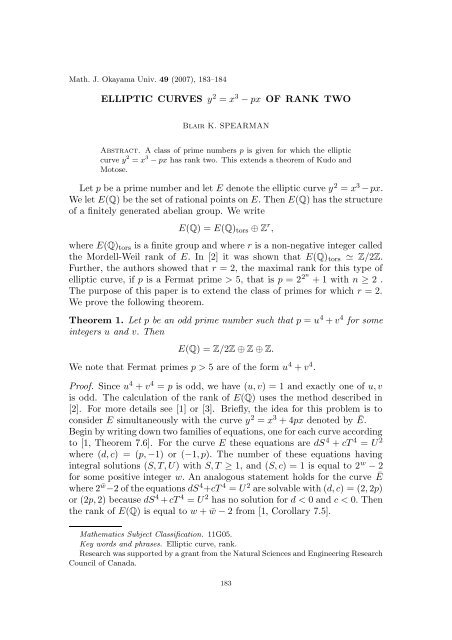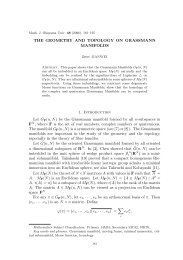ELLIPTIC CURVES y2 = x3 − px OF RANK TWO Let p be a prime ...
ELLIPTIC CURVES y2 = x3 − px OF RANK TWO Let p be a prime ...
ELLIPTIC CURVES y2 = x3 − px OF RANK TWO Let p be a prime ...
Create successful ePaper yourself
Turn your PDF publications into a flip-book with our unique Google optimized e-Paper software.
Math. J. Okayama Univ. 49 (2007), 183–184<br />
<strong>ELLIPTIC</strong> <strong>CURVES</strong> y 2 = x 3 <strong>−</strong> <strong>px</strong> <strong>OF</strong> <strong>RANK</strong> <strong>TWO</strong><br />
Blair K. SPEARMAN<br />
Abstract. A class of <strong>prime</strong> num<strong>be</strong>rs p is given for which the elliptic<br />
curve y 2 = x 3 <strong>−</strong> <strong>px</strong> has rank two. This extends a theorem of Kudo and<br />
Motose.<br />
<strong>Let</strong> p <strong>be</strong> a <strong>prime</strong> num<strong>be</strong>r and let E denote the elliptic curve y 2 = x 3 <strong>−</strong> <strong>px</strong>.<br />
We let E(Q) <strong>be</strong> the set of rational points on E. Then E(Q) has the structure<br />
of a finitely generated a<strong>be</strong>lian group. We write<br />
E(Q) = E(Q)tors ⊕ Z r ,<br />
where E(Q)tors is a finite group and where r is a non-negative integer called<br />
the Mordell-Weil rank of E. In [2] it was shown that E(Q)tors Z/2Z.<br />
Further, the authors showed that r = 2, the maximal rank for this type of<br />
elliptic curve, if p is a Fermat <strong>prime</strong> > 5, that is p = 22n + 1 with n ≥ 2 .<br />
The purpose of this paper is to extend the class of <strong>prime</strong>s for which r = 2.<br />
We prove the following theorem.<br />
Theorem 1. <strong>Let</strong> p <strong>be</strong> an odd <strong>prime</strong> num<strong>be</strong>r such that p = u 4 + v 4 for some<br />
integers u and v. Then<br />
E(Q) = Z/2Z ⊕ Z ⊕ Z.<br />
We note that Fermat <strong>prime</strong>s p > 5 are of the form u 4 + v 4 .<br />
Proof. Since u 4 + v 4 = p is odd, we have (u, v) = 1 and exactly one of u, v<br />
is odd. The calculation of the rank of E(Q) uses the method descri<strong>be</strong>d in<br />
[2]. For more details see [1] or [3]. Briefly, the idea for this problem is to<br />
consider E simultaneously with the curve y 2 = x 3 + 4<strong>px</strong> denoted by Ē.<br />
Begin by writing down two families of equations, one for each curve according<br />
to [1, Theorem 7.6]. For the curve E these equations are dS 4 + cT 4 = U 2<br />
where (d, c) = (p, <strong>−</strong>1) or (<strong>−</strong>1, p). The num<strong>be</strong>r of these equations having<br />
integral solutions (S, T, U) with S, T ≥ 1, and (S, c) = 1 is equal to 2 w <strong>−</strong> 2<br />
for some positive integer w. An analogous statement holds for the curve Ē<br />
where 2 ¯w <strong>−</strong>2 of the equations dS 4 +cT 4 = U 2 are solvable with (d, c) = (2, 2p)<br />
or (2p, 2) <strong>be</strong>cause dS 4 + cT 4 = U 2 has no solution for d < 0 and c < 0. Then<br />
the rank of E(Q) is equal to w + ¯w <strong>−</strong> 2 from [1, Corollary 7.5].<br />
Mathematics Subject Classification. 11G05.<br />
Key words and phrases. Elliptic curve, rank.<br />
Research was supported by a grant from the Natural Sciences and Engineering Research<br />
Council of Canada.<br />
183
184 B. K. SPEARMAN<br />
The equation pS 4 <strong>−</strong>T 4 = U 2 has a solution (S, T, U = (1, v, v 2 ) and clearly<br />
(S, c) = 1 where p = u 4 + v 4 .<br />
The equation <strong>−</strong>S 4 + pT 4 = U 2 has a solution (S, T, U) = (v, 1, u 2 ) and<br />
(S, c) = (v, p) = 1 for otherwise p | v so that 0 ≡ p = u 4 + v 4 ≡ u 4 (mod p)<br />
implying that p | u contradicting (u, v) = 1.<br />
We may assume u > v. The equation 2S 4 + 2pT 4 = U 2 has a solution<br />
(S, T, U) = (u <strong>−</strong> v, 1, 2u 2 <strong>−</strong> 2uv + 2v 2 ). If u ≡ v (mod 2) then we have a<br />
contradiction from p = u 4 + v 4 ≡ 2u 4 ≡ 0 (mod 2). If u ≡ v (mod p),<br />
then 0 ≡ p = u 4 + v 4 ≡ 2u 4 (mod p) so we have a contradiction 0 ≡ u ≡ v<br />
(mod p). Thus (S, c) = (u <strong>−</strong> v, 2p) = 1.<br />
Finally we consider the equation 2pS 4 + 2T 4 = U 2 which has a solution<br />
(S, T, U) = (1, u <strong>−</strong> v, 2u 2 <strong>−</strong> 2uv + 2v 2 ) and (S, c) = 1 where p = u 4 + v 4 .<br />
From these observations w = ¯w = 2 so the rank of E(Q) = w + ¯w <strong>−</strong> 2 = 2.<br />
This completes the proof. <br />
<strong>Let</strong> S denote the set of <strong>prime</strong>s of the form x 4 + y 4 and less than 10,000.<br />
Then we have<br />
S = {17, 97, 257, 337, 641, 881, 1297, 2417, 2657, 3697, 4177, 4721, 6577}<br />
References<br />
[1] J.S. Chahal, Topics in num<strong>be</strong>r theory, Kluwer Academic/Plenum Publisher, 1988.<br />
[2] T. Kudo and K. Motose, On Group structures of some special elliptic curves, Math.<br />
J. Okayama Univ. 47 (2005), 81-84.<br />
[3] J.H. Silverman and J. Tate, Rational points on elliptic curves, Springer New York,<br />
1985.<br />
Department of Mathematics and Statistics<br />
University of British Columbia Okanagan<br />
Kelowna, B.C. Canada V1V 1V7<br />
e-mail address: blair.spearman@ubc.ca<br />
(Received July 6, 2006 )<br />
(Revised Septem<strong>be</strong>r 21, 2006 )



